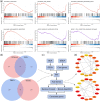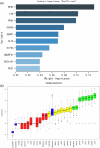Exploring biomarkers of premature ovarian insufficiency based on oxford nanopore transcriptional profile and machine learning
- PMID: 37460774
- PMCID: PMC10352282
- DOI: 10.1038/s41598-023-38754-x
Exploring biomarkers of premature ovarian insufficiency based on oxford nanopore transcriptional profile and machine learning
Erratum in
-
Author Correction: Exploring biomarkers of premature ovarian insufficiency based on oxford nanopore transcriptional profile and machine learning.Sci Rep. 2023 Aug 16;13(1):13311. doi: 10.1038/s41598-023-40482-1. Sci Rep. 2023. PMID: 37587238 Free PMC article. No abstract available.
Abstract
Premature ovarian insufficiency (POI) is a reproductive endocrine disorder characterized by infertility and perimenopausal syndrome, with a highly heterogeneous genetic etiology and its mechanism is not fully understood. Therefore, we utilized Oxford Nanopore Technology (ONT) for the first time to characterize the full-length transcript profile, and revealed biomarkers, pathway and molecular mechanisms for POI by bioinformatics analysis and machine learning. Ultimately, we identified 272 differentially expressed genes, 858 core genes, and 25 hub genes by analysis of differential expression, gene set enrichment, and protein-protein interactions. Seven candidate genes were identified based on the intersection features of the random forest and Boruta algorithm. qRT-PCR results indicated that COX5A, UQCRFS1, LCK, RPS2 and EIF5A exhibited consistent expression trends with sequencing data and have potential as biomarkers. Additionally, GSEA analysis revealed that the pathophysiology of POI is closely associated with inhibition of the PI3K-AKT pathway, oxidative phosphorylation and DNA damage repair, as well as activation of inflammatory and apoptotic pathways. Furthermore, we emphasize that downregulation of respiratory chain enzyme complex subunits and inhibition of oxidative phosphorylation pathways play crucial roles in the pathophysiology of POI. In conclusion, our utilization of long-read sequencing has refined the annotation information within the POI transcriptional profile. This valuable data provides novel insights for further exploration into molecular regulatory networks and potential biomarkers associated with POI.
© 2023. The Author(s).
Conflict of interest statement
The authors declare no competing interests.
Figures





Similar articles
-
Analysis of post-transcriptional regulatory signatures and immune cell subsets in premature ovarian insufficiency based on full-length transcriptome.Sci Rep. 2025 Feb 14;15(1):5533. doi: 10.1038/s41598-025-89391-5. Sci Rep. 2025. PMID: 39953072 Free PMC article.
-
Integrated metabolomics and transcriptomics to reveal biomarkers and mitochondrial metabolic dysregulation of premature ovarian insufficiency.Front Endocrinol (Lausanne). 2023 Dec 21;14:1280248. doi: 10.3389/fendo.2023.1280248. eCollection 2023. Front Endocrinol (Lausanne). 2023. PMID: 38179298 Free PMC article.
-
Identification of transcriptome characteristics of granulosa cells and the possible role of UBE2C in the pathogenesis of premature ovarian insufficiency.J Ovarian Res. 2023 Oct 17;16(1):203. doi: 10.1186/s13048-023-01266-3. J Ovarian Res. 2023. PMID: 37848988 Free PMC article.
-
Genetics of primary ovarian insufficiency: new developments and opportunities.Hum Reprod Update. 2015 Nov-Dec;21(6):787-808. doi: 10.1093/humupd/dmv036. Epub 2015 Aug 4. Hum Reprod Update. 2015. PMID: 26243799 Free PMC article. Review.
-
MicroRNAs in POI, DOR and POR.Arch Gynecol Obstet. 2023 Nov;308(5):1419-1430. doi: 10.1007/s00404-023-06922-z. Epub 2023 Feb 25. Arch Gynecol Obstet. 2023. PMID: 36840768 Review.
Cited by
-
Protective role of stem cells in POI: Current status and mechanism of action, a review article.Heliyon. 2023 Dec 6;10(1):e23271. doi: 10.1016/j.heliyon.2023.e23271. eCollection 2024 Jan 15. Heliyon. 2023. PMID: 38169739 Free PMC article. Review.
-
Analysis of post-transcriptional regulatory signatures and immune cell subsets in premature ovarian insufficiency based on full-length transcriptome.Sci Rep. 2025 Feb 14;15(1):5533. doi: 10.1038/s41598-025-89391-5. Sci Rep. 2025. PMID: 39953072 Free PMC article.
-
The Role of Artificial Intelligence in Female Infertility Diagnosis: An Update.J Clin Med. 2025 Apr 30;14(9):3127. doi: 10.3390/jcm14093127. J Clin Med. 2025. PMID: 40364156 Free PMC article. Review.
-
Absence of CDK12 in oocyte leads to female infertility.Cell Death Dis. 2025 Mar 27;16(1):213. doi: 10.1038/s41419-025-07536-w. Cell Death Dis. 2025. PMID: 40148269 Free PMC article.
-
Integrated metabolomics and transcriptomics to reveal biomarkers and mitochondrial metabolic dysregulation of premature ovarian insufficiency.Front Endocrinol (Lausanne). 2023 Dec 21;14:1280248. doi: 10.3389/fendo.2023.1280248. eCollection 2023. Front Endocrinol (Lausanne). 2023. PMID: 38179298 Free PMC article.
References
-
- European Society for Human, R. et al. ESHRE guideline: management of women with premature ovarian insufficiency. Human Reproduction (Oxford, England) 31, 926-937 (2016). - PubMed
Publication types
MeSH terms
Substances
LinkOut - more resources
Full Text Sources
Medical
Miscellaneous

